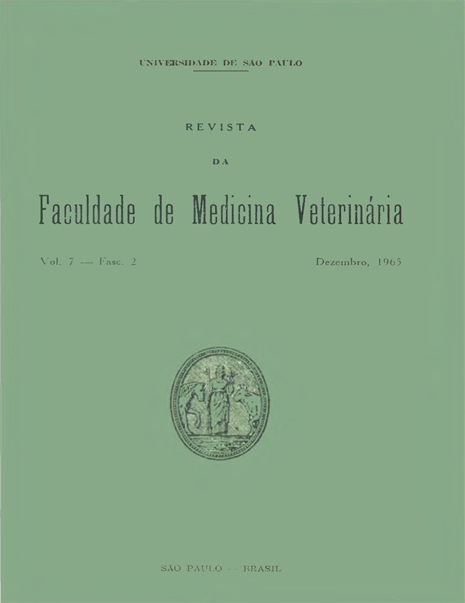Comparative study regarding the efficacy and effects of Dimethyl trichloro oxiethyl phosphonate and Thiodiphenilamine when used antihelminthcs among the nelore cattle
DOI:
https://doi.org/10.11606/issn.2318-5066.v7i2p429-465Keywords:
The article has no keywords.Abstract
This work describes various controlled tests that were conducted for the purpose of comparing the efficacy and effects of two antihelminthics (Dimethyl-Trichloro-Oxiethyl Phosphonate and Thiodiphenilamine) among the Nelore cattle raised on an extensive grazing in a pasture comprised of Panicum Maximum (colonião) grass. For such tests there was a selection of 21 heifers weighing between 128 and 227 kgs., which animals presented 200 or more “strongylides” eggs per gram of feces. Those heifers were sorted out at random in three groups of seven (7) animals each, one of which was left as a “stand by” group without any treatment at all. The two other groups were treated with Phenothiazine and “Neguvon”, respectively. At the end of the treatment, which lasted 25 days, four (4) animals of each group were sacrificed and a search for worms was performed in their gastrointestinal tracts. The efficacy of such treatments was noticed through the checking of worms in the feces. The efficiency of the antihelminthics was verified by means of hematological and biochemical testings of the serum and by weighing the animals. The results thus secured were analyzed statistically.
1 — The antihelminthic drugs (Demithyl-Trichloro-Oxiethyl Phosphonate “Neguvon” and Thiodiphenilamine (Phenothiazine) tested during this research presented antihelminthical results with an evident superiority performed by the “Neguvon”, as may be verified through the following facts:
a) Among those animals treated with the “Neguvon” drug there was a greater reduction of strongylides eggs per gram of feces, and a few animals even had negative results after the periodical tests.
b) No helminthics were found during the post-mortem tests performed among the Neguvon group of animals, while 50% of those treated with Phenothiazine showed worms in their gastrointestinal tubes.
c) The “Neguvon” product revealed a greater action spectro, thus evidencing that worms were reached within the abomasum, as well as within the small and large intestines, and presumably acting on Haemonchus contortux (Rud, 1803), Haemonchus similis (Travassos, 1914), Oesophagostomum radiatum (Rud, 1803), Cooperia pectinata (Ranson, 1907) and on Ostertagia ostertagi (Stiles, 1892) Ranson 1907. No action on Moniezia spp., Trichuris sp., and on Bunostomum Phlebotomum (Railliet, 1900) could be verified during our experiments.
d) The “Phenothiazine” acted on the worms in the abomasum and presumably on Haemonchus contortus (Rud, 1803), Haemonchus similis (Travassos, 1914), Cooperia pectinata (Ranson, 1907) and on Ostertagia ostertagi (Stiles, 1892) Ranson, 1907, but not being efficacious on Moniezia spp., Trichuris sp., Bunostomum Phlebotomum (Railliet, 1900) and neither on Oesophagostomum radiatum (Rud, 1803), which were found during the necroscopy performed among the animals treated with that product.
2 — Some general effects resulting from the administering of those drugs (antihelminthics) could be detected during the experiments which, in a general way, were unfavorable to the animals beloging to the “Phenothiazine” group, such as follows:
a) Reduction in the number of Erythrocyte per cubic millimeter per haemolyses among the animals belonging to the “Phenothiazine” group, while there no reductions in the number of erythrocytes among those animals in the “Neguvon” and “Stand by” groups.
b) Reduction in the haemoglobin rate in the “Phenothiazine” group, while the “Neguvon” group maintained its normal rate of haemoglobins, and the “Stand by” or withessing group of animals experienced and increase in theirs. The two previous items were confirmed by increase in the average of the Corpuscular Volume (VCM), as well as an increase in the Haemoglobin Corpuscular average (HCM) and a reduction in the Concentration of the Haemoglobin Corpuscular Average(CHCM) among the animals treated with “Phenothiazine”.
c) The antihelminthics tested did not show any toxic effects on the liver, when administered in therapeutical doses, for there was no evidence of significant differences as compared with the results obtained through dosage of total Proteins, Albumin, Globulins and total Lipids in the serum of the animals treated and of those belonging to the “stand by” group.
d) The using of “Phenothiazine” caused the animals to become thinner, with did not occur, in such an evident way, among the animals belonging to the “Stand by” group, and neither among those treated with “Neguvon”.
3 — No clinical symptoms of intoxication were observed in any of the animals that were treated with “Phenothiazine” or “Neguvon”, and during the necrospsies there was no evidence of macroscopic lesions that could be attributed to the antihelminthic used in the above cases.


